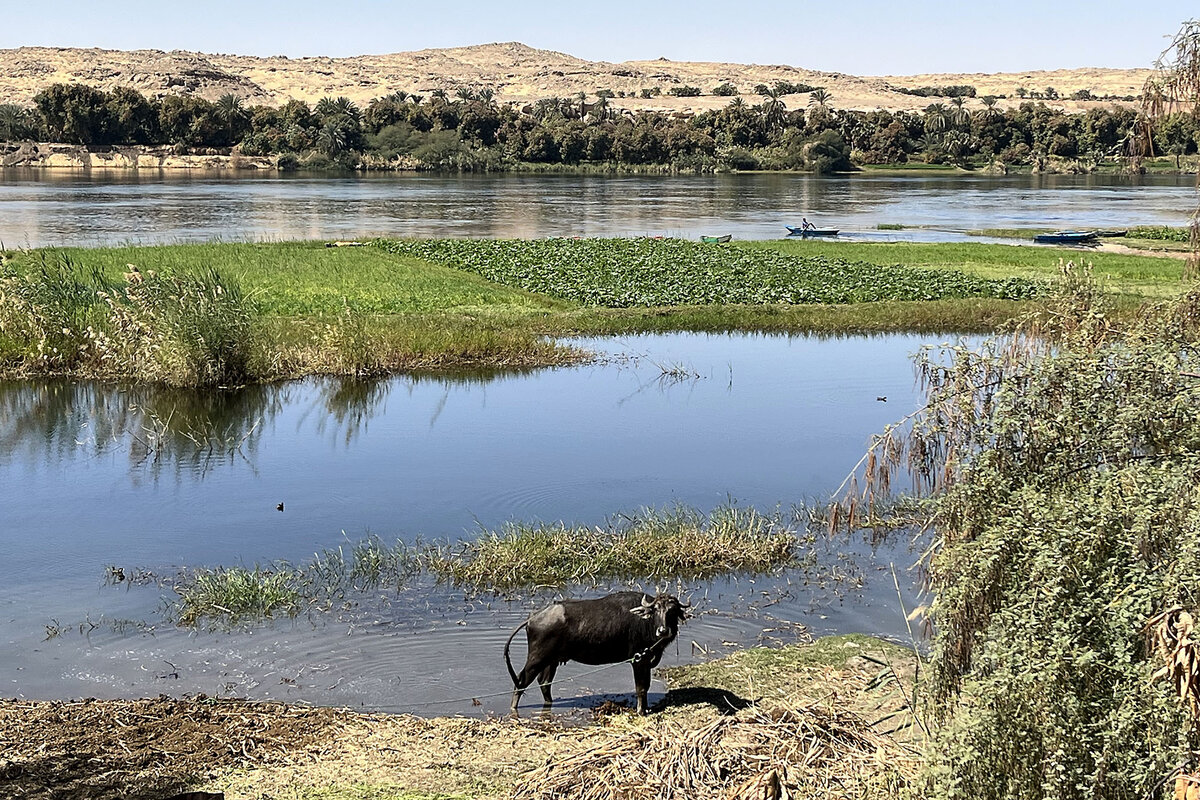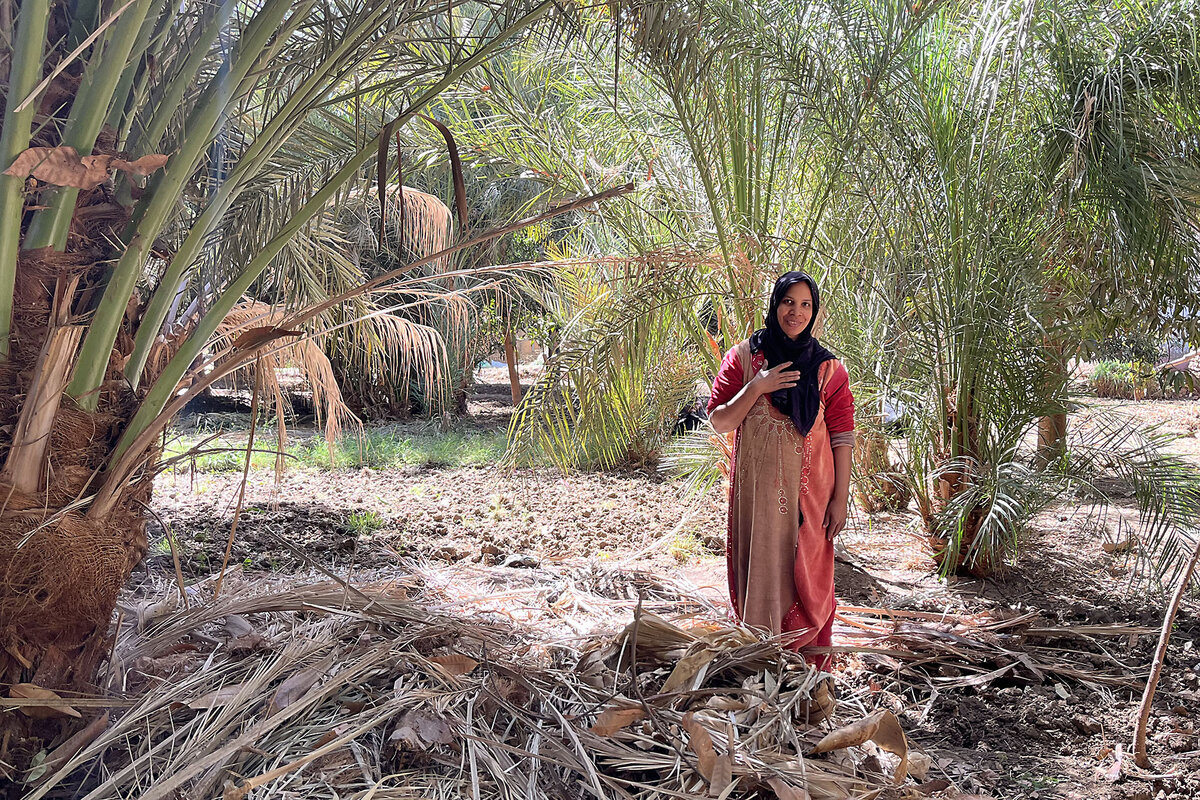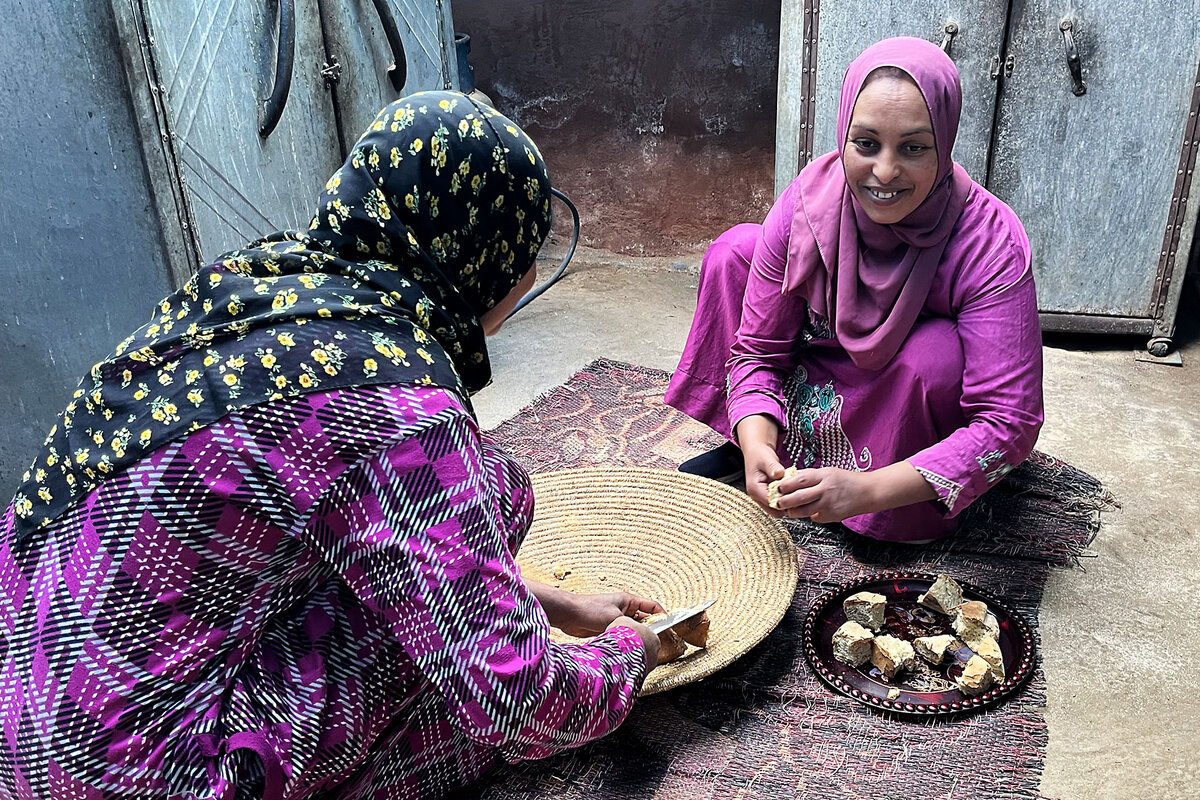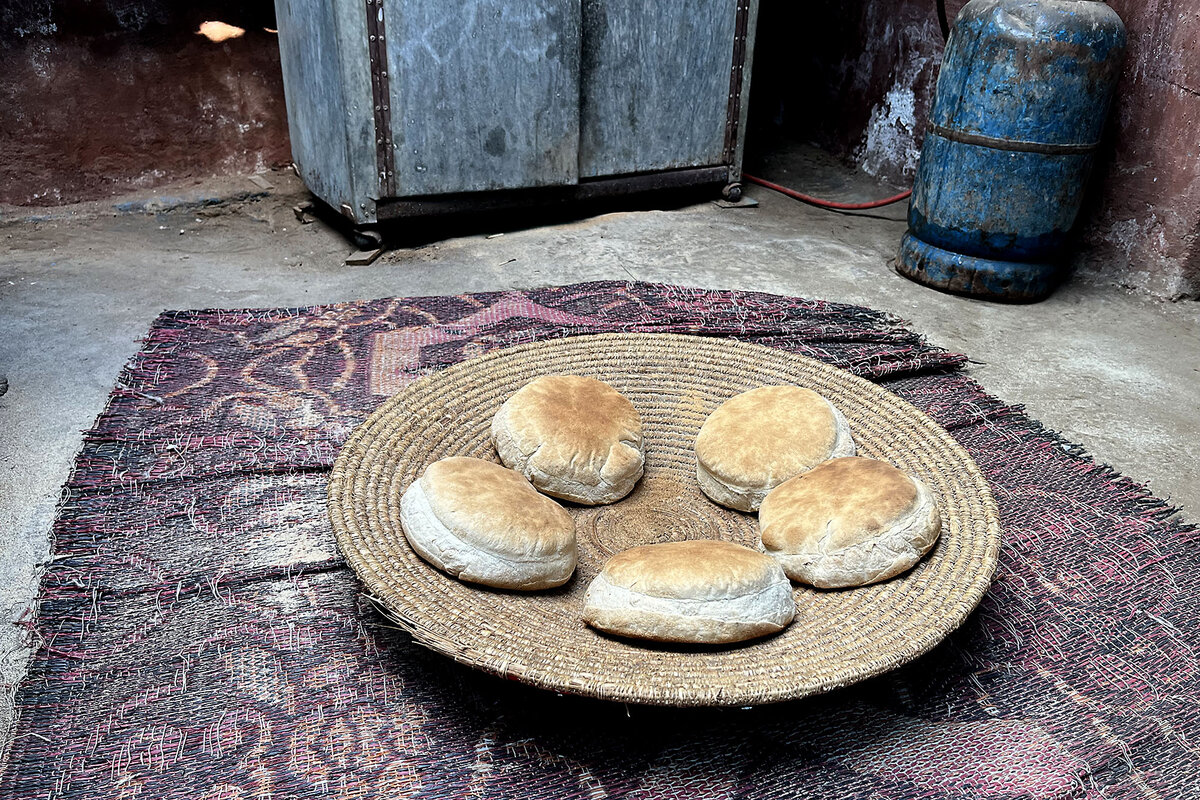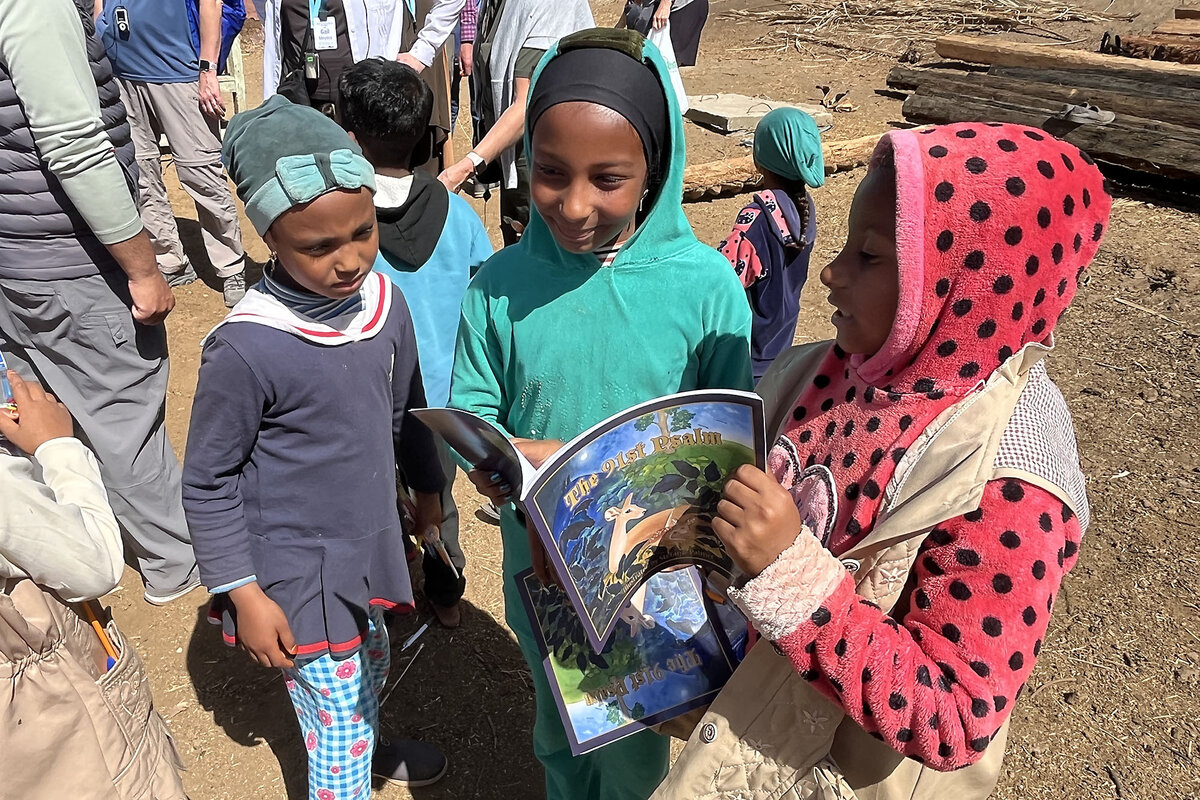Egypt’s pyramids are amazing. But so is present-day Besaw Island.
Loading...
| Besaw Island, Egypt
The Giza pyramids filled me with awe. But so did a different monument – a living wonder.
Day 7 of my February dream tour of Egypt was an inside view of village life and a villager’s home on a small island in the Nile River. On Besaw Island, we literally baked bread and broke it together. We weren’t just sailing by a pastoral scene from our traditional dahabiya boat; we were stepping into one.
Our first glimpse of the low-lying island, roughly 500 miles south of Cairo, is of a fisherman balancing skillfully atop his rowboat in the bulrushes. Nearby, Sayed Hassan waits for us at the bottom of the gangplank, smiling broadly in his long green robe – a galabia. He leads us along narrow raised paths through groves of mangoes, dates, and bananas. He stops to explain how they reproduce and are harvested, and that Egypt is the world’s largest producer of dates. A pleasantly warm sun filters through the fronds.
Why We Wrote This
Socially responsible tourism can take many forms. The cultural exchange offered by a trip to a rural island offers a window into another way of living for our reporter.
Our group of 35 – with Americans, Canadians, and an Australian – peppers him with questions, including how he climbs a tree for harvesting, to which he demonstrates by simply hitching up his robe. Otherwise, he answers in beautiful English, which he says he first learned from Americans, and then from books and YouTube. He confesses he’s a fan of actor Angelina Jolie.
I wasn’t sure what to expect from the day’s itinerary description: “We will explore a local island where fishermen and farmers live,” the program read.
As it turned out, this was an example of corporate social responsibility, practiced with love and care by our Egyptian tour guide operator, Holy Kemet. The company, which brings a historical biblical dimension to its tours, donates 5% to 10% of its profits to improving education on the island.
Social responsibility is a rapidly growing practice in the tourism industry, according to researchers. It includes sustainable tourism, contributions to local communities, and cultural exchange. A handful of other tourism companies also visit and contribute to the island. Holy Kemet has provided student notebooks, pencils, textbooks, desks, chairs, chalkboards, and lighting for the one-room schoolhouse. Next it wants to invest in iPads – and build a new school with multiple classrooms.
Our Holy Kemet guides named an additional motive for bringing us here. They want to discourage a resurgence of extreme Islam in Egypt, and the view that Westerners, particularly Americans, are evil. In an effort to roll that back, we came armed with lollipops and balloons for the children. “You guys are part of what’s happening here,” says Ahmed Salem, our behind-the-scenes organizer.
About 350 people live on the island, and each family has 3 acres, a motorboat, and a rowboat. That’s typical. Eighty percent of Egyptian farming units are small-scale, according to the World Bank. The farms cut a ribbon of green through the desert as they follow the life-giving flow of Africa’s longest river. But the small farms are inefficient and help explain a national poverty rate of more than 30%, the bank points out. Two-thirds of Egypt’s low-income residents live in rural areas.
But “poor” is not the word that comes to mind on our Besaw Island walkabout. Rather, it’s “balance,” and “joy.”
There are no pesticides here; ash strewn around the bottom of trees kills bacteria. Banana leaves become animal feed. Palm trunks and fronds serve as roof rafters and thatch for houses built of adobe and mud. A market boat stops by to pick up fresh produce and fish. Households have dual septic fields: When one fills, they use the alternate. Villagers rely on herbal remedies such as mint, cilantro, dandelions, and date palm. “We don’t get sick,” Sayed says, when asked about the lack of a hospital.
Agrarian simplicity coincides with basic modern conveniences. There’s no shortage of electricity, thanks to the enormous Aswan Dam, completed in 1970. The dam allows Egypt to achieve 100% access to power for its population. On the island, it juices televisions, smartphones, and swamp coolers. It powers two water stations – one for drinking, one for irrigation. The village, which came into being after the dam was built, would not exist without its regulation of devastating flood waters.
I mentioned joy. Inside and out, Sayed’s house is painted in the most cheerful colors – cerulean blue and mint green, with a mural of white swans floating along a grassy riverscape on the front exterior wall.
As we arrive, “the government” and “the president” come out to greet us – Sayed’s wife, in a magenta robe and headscarf, and his mother, in black. We are led to the living room – also the television room – where Sayed and his wife, Zainab, demonstrate how to bake round sun bread, which rises in the sun. We each place a long paddle on top of a loaf, flip it, and, with a quick shove, slide it into a gas-fired oven in the corner. Not so easy!
School is over, so while the loaves bake, we go outside to greet the boys and girls. They line up to receive their goodies, beaming. I hand out Crayola crayons and hard candies. A group of girls particularly likes a book of the 91st Psalm, illustrated with Australian animals by a member of our group.
Back inside, we sip fresh mango juice, enjoy our bread, and have a chance to tour the house – home to four families: Sayed’s, his two brothers’, and his parents. Upstairs, his brother proudly shows me a magnificently carved bedroom set, as well as his wedding album. Thick walls help regulate the temperature. Downstairs, a teenage boy takes me to the kitchen, where he shows off his catch of the day.
Our time comes to a close, and I still have many questions. We never got to see the island school or mosque. Eighty percent of the children choose to stay on Besaw, Sayed says. They love it. But what about the girls? The roles look to be traditional ones. Education for girls beyond middle school is controversial, as high school is on the mainland and girls can’t be spared from their domestic chores. Yet Sayed has a daughter who wants to be a doctor. “He fully supports her ambition,” says Dr. Salem, the Holy Kemet organizer, in a follow-up email.
Meanwhile, Dr. Salem describes Holy Kemet’s act of social responsibility here as a “pilot.” He hopes to convince the Egyptian government to spread the idea to corporate Egypt as a whole, where it can do good on a much larger scale than the seasonal tourism business.
This visit was a few hours, on one day – hardly a full view of rural life in Egypt. But it’s a window, nonetheless. And the thing about windows, they’re meant to look through. For our group, this one opened a new world, just as wondrous as the temples and tombs of ancient Egypt.






